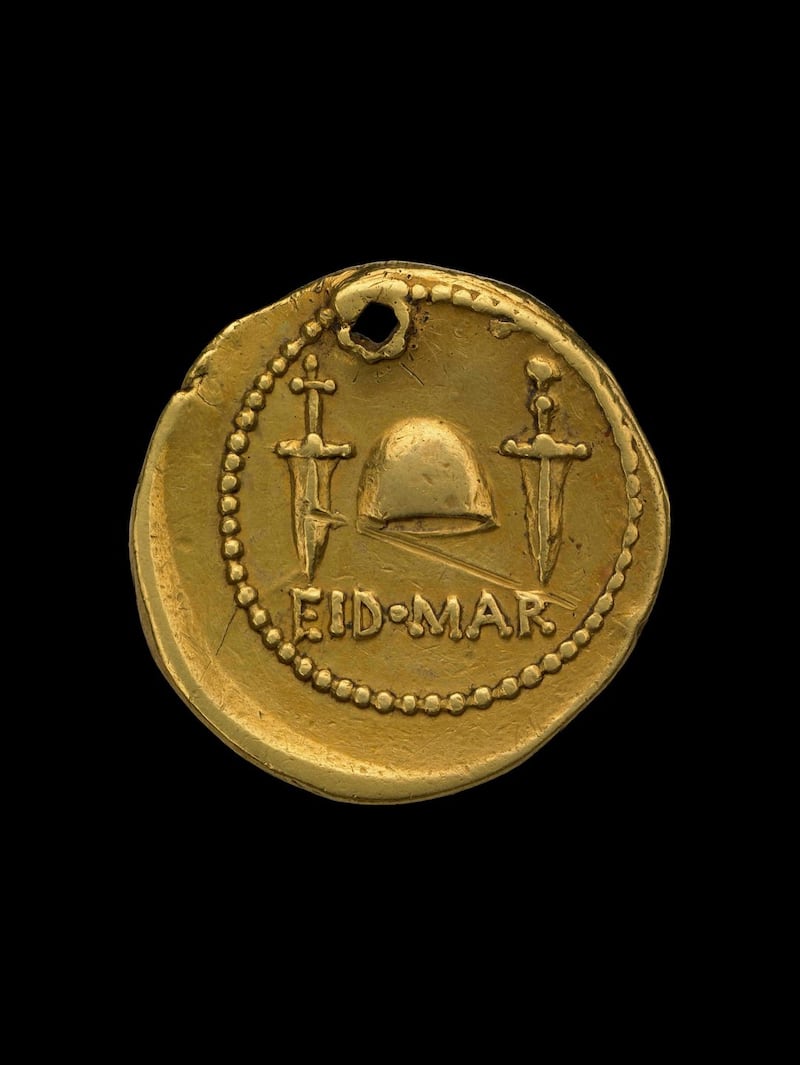“Well, the Ides of March are come,” Caesar said to the seer. “Yes, they are come,” came the reply, “but they are not gone.”
The most notorious assassination in history nearly did not happen. The night before Calpurnia dreamed she held her murdered husband in her arms. In the morning Caesar took her dream seriously. He ordered sacrifices to discern the future. All the omens were unfavourable. The conspirator Decimus Brutus had to cajole Caesar to attend the Senate. What would people think if Caesar heeded the dreams of a woman?
On the walk to the meeting an informant handed Caesar a message. “Read this, Caesar, by yourself and quickly; it contains matters of importance.” The multitude demanding attention distracted Caesar, and the denunciation of the conspiracy went unread.
The Senate was meeting in the theatre complex dedicated by Pompey, who had died after defeat by Caesar in civil war. Inside Cimber presented a petition. Caesar waved the Senator away. Whereupon Cimber seized Caesar`s toga, dragging it down from his neck. This was the signal. The conspirators drew their knives. The first blow was struck by Casca. The wound was superficial, but in a moment Caesar was surrounded. The majority of the Senate, not privy to the plot, sat in horrified silence, too petrified to flee. According to Plutarch, Caesar fought back; “hemmed in on all sides, whichever way he turned confronting blows of weapons aimed at his face and eyes, driven here and there like a wild beast”. In the account of Suetonius, after an initial groan, Caesar did not make a sound until he saw Marcus Brutus, dagger in hand. “You too, child,” Caesar said in Greek.

Caesar died at the foot of Pompey`s statue. His blood splashed its pedestal. Now those not in the intrigue, utterly terrified, scrambled out of the theatre. Denied the chance to harangue the Senate, Marcus Brutus led his fellow conspirators up to the capitol. They waved their bloodstained daggers aloft, calling out “Liberty!” to anyone who had not run away. Caesar`s corpse, pierced by 23 wounds, was left abandoned. Some hours later, three slaves carried it away, one arm exposed and hanging down.
The self-styled “liberators” believed that once they had killed Caesar liberty would be restored, the rise of autocracy would be halted, and the free Republic would function again. They were wrong. For all its fine sound, the liberty they proclaimed essentially was that of their own class to dominate politics, manipulate justice and reap the benefits of empire.
They had not considered the interests of three other groups in Roman society. The urban plebs of Rome had no desire to return to being ruled by squabbling oligarchs. The tens of thousands of Caesar’s soldiers and veterans were unmoved by the call to a Senatorial-controlled “Restored Republic”. And there were those politicians, principally Mark Antony and Octavian, who wanted to be Caesar’s heir. After a political compromise that lasted little more than a week, the empire inexorably moved to renewed armed conflict. Out of the years of ensuing bloodshed and civil war, Octavian emerged the victor. As the first Emperor Augustus, he established an autocracy that would endure as long as the Roman empire survived.


As the “liberators” failed, do the Ides of March still matter, and do they have any contemporary significance?
The Ides of March are a potent way into debating the rights and wrongs of political assassination, “regime decapitation” and the recourse to violence. In a phrase much employed by modern scholars they are “good to think with”. The killing of Caesar can be spun in diametrically opposed ways. All the knife-wielding Senators in the theatre of Pompey owed something to the man they butchered; political advancement, pardon for previously bearing arms against him, or both. All were bound to him by what the Romans called amicitia, political and public friendship. Several, like Marcus Brutus, were considered personal friends of Caesar.
One interpretation is to see Marcus Brutus and his fellow conspirators as noble tyrannicides. These were men who acted on principle, in some cases fortified by philosophy. They would put aside their personal feelings, suppress their horror at the deed. Risking everything, they acted out of duty for the public good, striking down a tyrant to restore freedom to the state.
The opposed view stresses treachery. This was an act of savage, yet ultimately futile, personal betrayal, motivated by jealousy and self-interest. Forgetting the amicitia they shared with Caesar, and the debts they owed him, they slaughtered their defenceless benefactor and friend. This interpretation emphasises the pathos of one, unarmed man hacked to death by a mob.
From the moment of Caesar’s death the two rival views began a struggle for supremacy that lasted through the rest of antiquity. Cicero was in the noble tyrannicide camp. If anything, it had not gone far enough. If Cicero had been invited into the conspiracy, Mark Antony would have been killed as well. Yet for Cicero’s correspondent Gaius Matius, it was not a question of tyranny, but of friendship. Matius might not have approved of what Caesar was doing, but he grieved for his friend.
Perhaps surprisingly, the debate continued under the rule of the emperors. In an epic poem written under Nero, Lucan described the murder of Caesar as a fitting punishment of a tyrant, and a warning to all of their kind. Yet the third century AD senator and historian Cassius Dio wrote that the Ides “added a new name to the annals of infamy”. Although usually not going as far, most surviving classical commentators incline to the latter view. Plutarch was more equivocal. Brutus acts nobly in his biography, while the pathos of the victim is central to the Ides of March in that of Caesar.
The Middle Ages, after the fall of Rome, was a time of monarchy. Justifications of regicide were far from welcome. The Ides of March as faithless perfidy held the field. Dante, in The Divine Comedy, consigned Marcus Brutus and his co-conspirator Cassius to the lowest circle of Hell. There Lucifer, the “emperor of that woeful realm”, devoured them in two of his three mouths. In the third was Judas Iscariot. Brutus and Cassius had betrayed Caesar, just as Judas had betrayed Christ. Caesar himself was to be found among the virtuous pagans.
In the Renaissance the debate was reignited, above all by the rediscovery of Plutarch. The defining modern image of the Ides of March was created by William Shakespeare in his play Julius Caesar. Shakespeare engaged with Plutarch through the translation in The Parallel Lives of the Most Noble Greeks and Romans by Sir Thomas North. When first produced in 1599, Julius Caesar raised urgent contemporary political issues. Elizabeth I was aged and ailing. The succession was unclear. There had been plots against her life, and there was a real threat of civil war. But it was the universal questions raised that have given the play enduring relevance. As Maria Wyke has written, “Julius Caesar encourages its audience to consider how you distinguish envious murderers from heroic patriots, and how you distinguish bloody murder from noble assassination”.
Public duty is put in the balance against private friendship. Shakespeare raises the questions, but gives no simple answers. He adopts the equivalence of Plutarch on the Ides of March. The play is a tragedy of both Caesar and Brutus.
The politics of no country have been affected more by the Ides of March than those of America. In the 18th century Shakespeare’s Julius Caesar was frequently performed in the years leading up to the American Revolution. It was understood totally in the noble tyrannicide tradition, as a call to arms for liberty against English tyranny. At times the text had to be drastically altered to give the right moral. The Founding Fathers, emulating Roman senators, hankered to be like Brutus. In the following century an individual took things much further. In 1865, having assassinated President Lincoln, the actor John Wilkes Booth shouted “Sic semper tyrannis”. Afterwards, in the diary he kept while on the run, Booth wrote that every man’s hand was against him “for doing what Brutus was honoured for”.
Julius Caesar continues to be widely performed in America. Interestingly the dominant theme of recent productions, almost invariably in modern dress, seems to focus on a warning against “regime decapitation”. During the second Gulf War there was much talk of a targeted strike on Sadam Hussein. In 2002, in the run up to the invasion of Iraq, the director of a revival in Chicago talked about the questions she thought were asked by the play.
Among them were “Is the assassination of a world leader really the answer to complex problems?”, and “Does violence itself do good?”. For her the questions appear to be rhetorical, but The Ides of March, as mediated via Shakespeare, remain as ever “good to think with”.
- Harry Sidebottom is a lecturer in Ancient History and Classics at Lincoln College and author of The Last Hour, which is out now


















